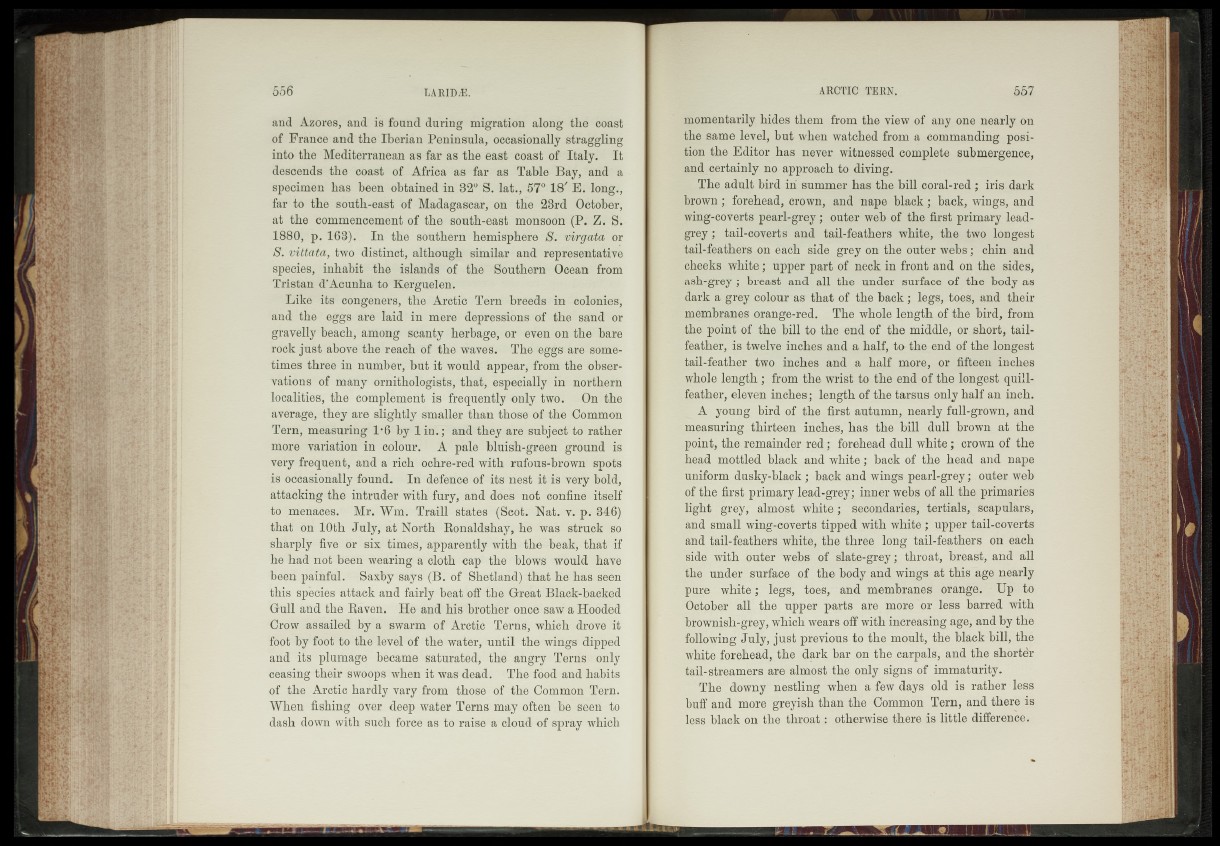
and Azores, and is found during migration along the coast
of France and the Iberian Peninsula, occasionally straggling
into the Mediterranean as far as the east coast of Italy. It
descends the coast of Africa as far as Table Bay, and a
specimen has been obtained in 32° S. lat., 57° 18' E. long.,
far to the south-east of Madagascar, on the 28rd October,
at the commencement of the south-east monsoon (P. Z. S.
1880, p. 168). In the southern hemisphere S. virgata or
S. vittata, two distinct, although similar and representative
species, inhabit the islands of the Southern Ocean from
Tristan d’Acunha to 'Kerguelen.
Like its' congeners, the Arctic Tern breeds in ' Colonies,
and the eggs are laid in mere depressions of the sand or
gravelly beach, among scanty herbage, or éven on the bare
rock just above the reach of the waves. The eggs are sometimes
three in number, but it would appear, from the observations
of many ornithologists, that, especially in northern
localities, the complement is frequently' only two. On the
average, they are slightly smaller than those ofJfhe Common
Tern, measuring 1*6'by 1 in.; and they are subj-ectto rather
more variation in colour. I A pale bluish-green aground is
very frequent, and a riCh hchre-red with rufous-bröwn spots
is occasionally found. In defence ofs its" nést iiüswery bold,
attacking the intruder with fury, and dóes -not confine itself
-to .menaces. Mr. Wm. Traill states- "(Sfeot. Nat. v. p. 816)
that on 10th July, atiKorth -Ronaldshay, he was struck So
sharply five or six times, apparently with thè^béah^'that -if
he had not been wearing a cloth'cap^ the'1 blows would ?kave
been painful. Saxby says^'(ifl of Shetland) that he has/seen
this species attack and fairly bekt off -the -Great ^Black-backed
Gull and the Raven* * He and his “brother once saw. a-Hooded
Crow assailed by- a swarm ''oP^frctic T^rns*, whieh'Mrove fit
foot by foot to the level of the water, until%he-wings:rdipped
and its plumage bëcame saturated;; thé- angry Terns Sanl'y
ceasing their 'Swoops when it was dead. The-food and habits
of Arctic hardly vary from tho|h-d|%hl'. pommon Tern.
When fishing over deep water Terns may- .Qftén #lé4*éeen'---^o
dash down with such foree as to raises cloud of spray which
momentarily hides them from the view of any one nearly on
the same level, but when watched from a commanding position
the Editor has never witnessed complete submergence,
and^certainly no approach to diving.
The adult bird in" summer has the bill coral-red ; iris dark
%ownforehead, crown, and nape black ^. back, wings, and
wing-coverts pearl-grey; outer web of the first primary lead-
grey ; tail-eoverts and tail-feathers white, the two longest
tail-feathers on each side grey on the outer webs ; chin and
cheeks white; upper part of neck in front and on the sides,
ash-grey; breast and all the under surface of the body as
dark a grey colour as that of the back; legs, toes, and their
membranes orange-red. The whole length of the bird, from
the point of the bill to. the end of the middle, or short, tail-
feather, is twelve inches and a half, to-the end of the longest
l^iL-feather two inches and a hjjf. more, or fifteen inches
whole length^; from the wrist to the end of the longest quill-
feather, eley^p. inches; length of the tarsus only half an inch.
^ A young bird of the first autumn, nearly full-grown, and
measuring thirteen inches,'has the bill dull brown at the
§fpint, the remainder red.; forehead dull white.; -crown of the
head mottled black and ^iiite; back of the head and nape
uniform dusky-black; back and wings pearbgrey; ou||gweb
spf the first primary lead-grey; in^pr.webs of ah. the primaries
'light i'grëy, almost^While ;" secondaries; tertials, scapulars,
f|pd small wing-coverts tipped with white; upper tail-coverts
and tail-feathers' white, the three flrong tail-featl^s; on each
side with, outer webs' of slat,e-grey; throat, breast, and all
the under ' surface éh the body and wings at this age nearly
pure' white1;' legs, toes, and membranes orange. - Up to
^October all the upper parts are moré or lhss barred with
brownish-gfey, whichwears off with increasing age, and by the
following July,.,j.ust previous to the moult, the black bill, thé
®Ê|e forehead, the dark bar on the carpals, and the shorter
iafl-streamfls are almost the only signs of immaturity.
* The" downy11 nestling when a few days old is rather less
huff and more greyish thanrthe ■ Common Tern, and there is
“less black on the throat: otherwise there is little difference.